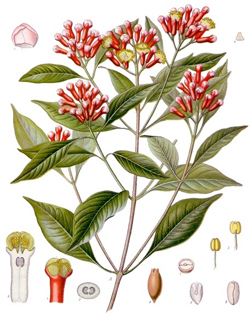

Cloves
Description
Cloves (Syzygium aromaticum) are the
aromatic, dried, fully grown
flower buds (unopened) of
the clove tree.
Native to the Maluku Islands (historically called
the Spice Islands), the clove tree is a pyramidal,
evergreen and broad-leaved tree that grows about 20
to 45 feet tall.
Kautilya Commodities
is a supplier of cloves from Madagascar.

The Clove Tree
(Source:
http://pharm1.pharmazie.uni-greifswald.de/allgemei/koehler/koeh-eng.htm)
Growth
The clove tree takes
about 6 to 8 years for flowering, after planting and
the buds take another 6 months to mature. The flowering starts
during August / September to February depending on
the altitude (earlier in low elevation areas and
later in higher ones). The harvesting period
is normally from February to March. Clove
trees thrive on abundant rainfall at least 60 inches
per year and a dry season during which the flower
buds are hand-picked and sun-dried till they turn a
deep-brown and then packed. Though a clove tree may
live 100 years, it flowers best when it is between
15 and 20 years old. After that time, yield
decreases significantly. The yield of cloves
varies with age, size and condition of trees. An
average yield of 3.5-7.0 kg dry clove per tree per
year is
obtained, though the figure can surprisingly go much
higher depending on various factors such as the
genetic quality of the tree, the soil, the age and
the climate.
Our collectors are
trained for identifying the correct buds based on
size and colour.
Nutritional Info (
typical values per 100g) :
Energy (Kcal) : 430 / Energy (kJ) : 1789.10 /
Protein : 6.0g / Carbonhydrate : 68.8g / Fibre :
12.1g /Fat : 14.5g / Sodium : 250mg / Water: 5.0g
Moisture content : 8-15% Maximum / Total ash : 2-5%
Grading
We grade cloves in to
different categories given below in descending order
of quality:
1. Hand-picked
/ CG-1 -
This is the highest
quality which entails manual sorting of the cloves
at a microscopic level.
There could be
a certain percentage in the range of 3 % of baby
cloves / stems but can be maintained below that..
2. CG-2 -
Percentage of baby cloves and stems is higher, low
ash content.
3. CG-3 -
Percentage of baby cloves, stems, ash content
higher.

Sample picture of a crop of cloves from Madagascar
Clove
oil can be extracted from the leaves, stem and buds.
We sell clove leaf oil as well as oil extracted from
the stem and buds. Clove leaf oil is extracted
by water distillation, containing the desired lower
percentage of eugenol.

A darker variant of cloves from Madagascar
Kautilya Commodities is an
exporter of cloves from Madagascar adhering to the
specifications requested by the customer. We
are also an exporter of clove stems
We will be uploading
pictures of fresh stocks of clove stems from
Madagascar in the last quarter of 2013. Clove
stems are used in the extraction of clove oil and
the clove stems we export are selected on the basis
of high oil content.
For further
information about the availability, quality, price
of cloves, clove stems and clove oil, please
contact us.
Home
















